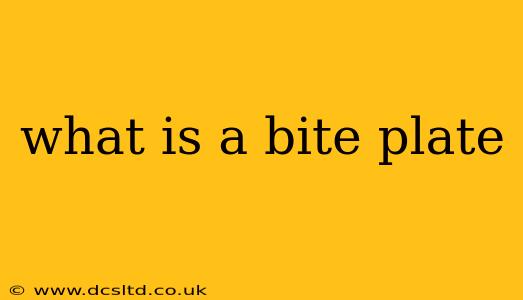A bite plate, also known as a bite splint or occlusal splint, is a custom-made oral appliance designed to improve dental health and alleviate various oral and jaw issues. It's typically made from acrylic resin or other durable materials and fits snugly over the upper or lower teeth. Unlike retainers, which primarily maintain tooth position after orthodontic treatment, bite plates serve a broader range of therapeutic purposes. This guide will delve into the different types, uses, benefits, and potential drawbacks of bite plates.
What are the Different Types of Bite Plates?
Bite plates are categorized based on their design and intended use. Some of the common types include:
- Michigan Splint: This is a relatively flat, hard acrylic plate covering the maxillary (upper) arch. It's often used to treat temporomandibular joint (TMJ) disorders.
- Maryland Splint: This covers both the upper and lower teeth and allows for a more controlled bite relationship. It's frequently used for bruxism management (teeth grinding).
- NTI-tss (Nociceptive Trigeminal Inhibition device): This small appliance covers only the front teeth and helps prevent clenching and grinding, primarily focusing on the muscles of mastication.
- Stabilization Splints: These are designed to stabilize the jaw joint and reduce pain in individuals with TMJ disorders.
The specific type of bite plate recommended will depend on the individual's needs and the condition being treated.
What are Bite Plates Used For?
Bite plates have a wide array of applications in dentistry. Their primary uses include:
- Treating Temporomandibular Joint (TMJ) Disorders: Bite plates can help alleviate pain and discomfort associated with TMJ disorders by altering the position of the jaw and reducing strain on the jaw joints and muscles.
- Managing Bruxism (Teeth Grinding): By providing a protective barrier between the upper and lower teeth, bite plates minimize the wear and tear on tooth enamel caused by bruxism.
- Treating Sleep Apnea: Certain types of bite plates, often called mandibular advancement devices (MADs), help reposition the lower jaw forward to keep the airway open during sleep.
- Protecting Teeth After Dental Procedures: Bite plates can be used to protect teeth during or after dental procedures such as orthodontics, extractions, or other restorative work.
- Improving Occlusion: In some cases, bite plates are used to correct minor occlusal discrepancies (the way upper and lower teeth fit together).
How Long Do I Need to Wear a Bite Plate?
The duration of bite plate wear varies significantly depending on the individual and the underlying condition. Some individuals may only need to wear it at night, while others might need to wear it throughout the day. Your dentist will determine the appropriate wearing schedule based on your specific needs and progress. It's crucial to follow your dentist's instructions precisely to achieve the desired results.
What are the Potential Side Effects of a Bite Plate?
While generally safe and effective, some individuals may experience mild side effects such as:
- Increased Saliva Production: Initially, your mouth might produce more saliva than usual.
- Slight Discomfort: Some mild discomfort or soreness may be felt in the initial days of use.
- Speech Impediment: In the early stages, it might slightly affect your speech, but this typically resolves quickly.
More serious side effects are rare but should be reported to your dentist immediately.
Are Bite Plates Expensive?
The cost of a bite plate can vary depending on the type of splint, the materials used, and the dentist's fees. While the initial investment might seem significant, it's often a cost-effective solution compared to long-term management of TMJ disorders or other oral conditions. Insurance coverage may vary. It's best to discuss the cost with your dentist beforehand.
Can I Make My Own Bite Plate?
No. You should never attempt to make your own bite plate. Custom-made bite plates are precisely crafted to fit your specific jaw and teeth structure. Improperly fitting or constructed bite plates can cause more harm than good, potentially leading to further dental or jaw problems. Always consult with a qualified dentist for a properly fitted and effective appliance.
This comprehensive guide should provide a better understanding of what a bite plate is and its many uses. Remember to consult with a dental professional for diagnosis and treatment of any oral health concerns.
